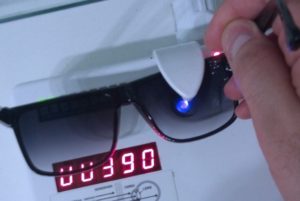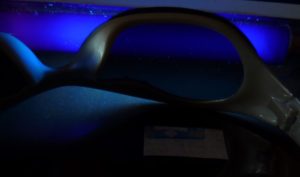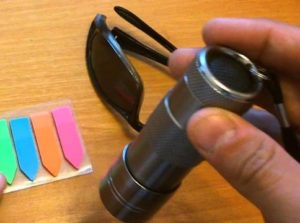All sunglasses are considered to have UV protection. However, this is not true in the case of cheap plastic glasses. If you want to buy a high-quality stylish accessory, learn to distinguish ordinary plastic from a fake. So what does it take?
How to check whether glasses allow ultraviolet light to pass through?
It is best to conduct a test at the point of purchase and before making it. To ensure everything goes smoothly, take a UV flashlight with you.
A simple way with a device
 Stores specializing in the sale of sunglasses and glasses must have a spectrometer. The buyer has the right to use it and check the product before purchasing, you just need to ask the seller to provide access “to the device”. The check itself takes only a few seconds. It is enough to bring the glass to the reading element, literally immediately after that the numbers will appear on the screen. This will be the required indicator.
Stores specializing in the sale of sunglasses and glasses must have a spectrometer. The buyer has the right to use it and check the product before purchasing, you just need to ask the seller to provide access “to the device”. The check itself takes only a few seconds. It is enough to bring the glass to the reading element, literally immediately after that the numbers will appear on the screen. This will be the required indicator.
Important! Don't forget to check the resulting number with what the manufacturer stated in the description.If the values do not match, there is a high probability that you are holding in your hands not the original, but a copy.
In addition to the spectrometer, a photometer is used to determine UV transmittance. It does not show numbers, but the type of lenses. Explanation of values:
- DANGER – red light – a signal that the lens transmits over 12% of UV rays;
- CAUTION – yellow light – the lens transmits 4–7% of UV rays;
- SAFE – green light indicates high glass protection.
Try to purchase products that were classified as SAFE when testing the photometer.
Checking without technology
 It is impossible to determine the presence of protection “by eye”, since human vision does not perceive ultraviolet radiation, it simply does not see it. To confirm this, illuminate the lenses with a UV flashlight. You won't notice anything unusual.
It is impossible to determine the presence of protection “by eye”, since human vision does not perceive ultraviolet radiation, it simply does not see it. To confirm this, illuminate the lenses with a UV flashlight. You won't notice anything unusual.
To be able to see the difference between glass with and without ultraviolet protection, you will need a beam source of the appropriate type and an object with luminescent properties. For example, a sticky note, pen or marker. This thing is placed on the table and the light of a flashlight is directed at it. The glasses are placed between the flashlight beam and the luminescent object.
If the manipulation led to the item being illuminated, then this indicates that the glass does not have protection against UV radiation. If the glasses did not let the rays through, then you can safely purchase the pair in question.
Checking with a flashlight and writing
 The technique is in many ways similar to the previous one, but you don’t have to look for an object with luminescent properties. It is enough to take a ticket, excise tax or passport and illuminate it with a flashlight with UV radiation (don't forget to place glasses between them). Invisible holographic signs begin to glow when exposed to ultraviolet light.If there is no glow and no inscriptions or signs appeared during the experiment, then this indicates that a particular pair has UV protection.
The technique is in many ways similar to the previous one, but you don’t have to look for an object with luminescent properties. It is enough to take a ticket, excise tax or passport and illuminate it with a flashlight with UV radiation (don't forget to place glasses between them). Invisible holographic signs begin to glow when exposed to ultraviolet light.If there is no glow and no inscriptions or signs appeared during the experiment, then this indicates that a particular pair has UV protection.
Important! Do not try to verify Visa cards using this method. The invisible inscription on them will glow in any case, regardless of the quality of the sun protection accessory.
Testing by practice
The method is suitable for those who has the opportunity to be in the sun for several days in a row and tans quickly enough. If after this time the face changes color, and the skin under the eyes remains approximately the same shade, then we can say that the glasses have protective qualities. True, the severity of the property cannot be determined in this way.
Check with BLB lamp and white cloth
Turn on the light source and place a completely white cloth in front of it. Place glasses between them. If they are of high quality and do not transmit UV rays, then there will be no luminescent effect.
What are the parameters of glasses with 100% protection?
Just seeing the protection indicator is not enough. It is necessary to compare the numbers obtained when checking with a spectrometer with a reference point. In sun protection products, the optimal level of ultraviolet protection looks like this: UV400. If the device showed exactly this figure, then everything is in order, if less, the radiation will reach the eyes.
Important! The only valid option besides UV400 is UV380. Glasses with this indicator are not ideal, but are still able to cope with the task.
Also, do not be mistaken and think that the color of the glass affects something. Lenses with an impenetrable black color can be absolutely useless in terms of protection from UV rays, while an accessory with a green tint, on the contrary, does not allow harmful radiation to pass through.
Recommendations for choosing good glasses
 Pay attention to the temples. This is where manufacturers most often indicate the presence and level of ultraviolet protection. It may look like this: CE or UV400.
Pay attention to the temples. This is where manufacturers most often indicate the presence and level of ultraviolet protection. It may look like this: CE or UV400.
Do not buy glasses from markets and street stalls. Firstly, there are no instruments with which you can verify the properties of the product. Secondly, in this way they usually sell counterfeit and low-quality products that have not passed the necessary tests.
Don't try to save money. Reliable sunglasses cannot cost less than 1 thousand rubles. Exception: sales.


 1
1






But what about the glasses sold in fix price stores!? legal and legal. Is it possible? and why buy them